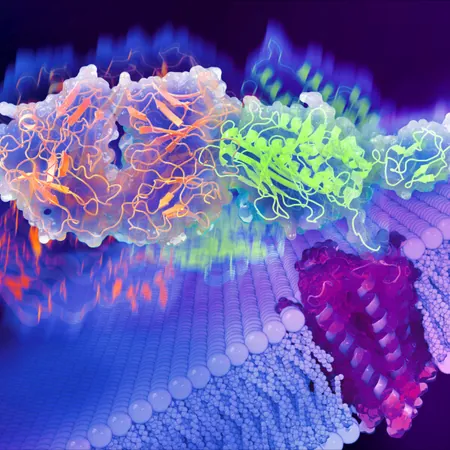
Revolutionary Insights on Cell Receptors Spark Hope for New Drug Discoveries!
2024-12-27
Author: Sarah
Groundbreaking Study at the University of Chicago
In a groundbreaking study at the University of Chicago, researchers have successfully captured intricate images of adhesion G protein-coupled receptors (aGPCRs) and identified an alternative method of activating these pivotal cell receptors. This advancement could potentially revolutionize drug design, opening new avenues for targeting diseases previously thought untreatable.
The Importance of G protein-coupled Receptors
G protein-coupled receptors (GPCRs) are critical proteins embedded in cell membranes and account for nearly 35% of all drugs approved by the Food and Drug Administration (FDA). However, the aGPCRs—the second largest family of receptors in the human body—remain largely uncharted territory in drug development, with no approved medications targeting them. These receptors play a vital role in numerous physiological processes, including tissue growth, immune responses, and organ formation. When malfunctioning, they can contribute to severe health issues such as cancers, neurological disorders, and developmental growth problems.
Innovative Imaging Techniques Used
The research team at UChicago utilized a combination of two powerful imaging techniques to build a comprehensive picture of a common aGPCR. They focused on how the complex extracellular region—extending beyond the cell membrane—interacts with the transmembrane region of the receptor. This intricate communication might be the key to triggering the receptor's activation.
Significance of the Discovery
Dr. Demet Araç, associate professor of biochemistry and molecular biology at UChicago, emphasized the significance of this breakthrough: "This opens up new opportunities for drugging adhesion GPCRs, because the extracellular region is communicating with the transmembrane region." This discovery may pave the way for novel therapeutic interventions that leverage the unique activation mechanisms of aGPCRs.
Revising Previous Assumptions on Activation
Interestingly, the aGPCRs’ activation was previously thought to depend on a ligand from outside the cell binding to specific extracellular domains, leading to the cleavage of the GAIN (GPCR Autoproteolysis INducing) domain. This cleavage results in a tethered agonist (TA) that activates signaling pathways. However, recent studies indicate that many aGPCR functions do not rely solely on this cleavage-dependent mechanism, suggesting alternative activation methods are at play.
Research Focus on Latrophilin3
For over a decade, Araç's lab has aimed to elucidate the full-length structures of aGPCRs to understand how external signals are transmitted inside the cell. The research spotlighted Latrophilin3, a specific aGPCR linked to brain synapse development and disorders including attention deficit hyperactivity disorder (ADHD) and specific cancers.
Challenges and Breakthroughs in Imaging
Lead graduate student Dr. Szymon Kordon faced a series of challenges in capturing clear images of the receptor. Collaborating with Dr. Antony Kossiakoff, a distinguished professor of biochemistry, they engineered a synthetic antibody that stabilized the extracellular region and enabled high-resolution images using cryo-electron microscopy (cryo-EM). These images revealed the first complete snapshot of an aGPCR, demonstrating that the GAIN domain can adopt multiple configurations in relation to the cell surface, each possibly representing different communication roles with the transmembrane region.
Dynamic Studies with FRET Imaging
To delve deeper into these findings, the research team, alongside experts from Northwestern University, employed FRET imaging to study the dynamic movements of the extracellular and transmembrane domains. The results confirmed their hypothesis about the potential for different configurations to modulate receptor activity without the irreversible cleavage previously assumed necessary.
Implications for Drug Development
The implications of this study, published in *Nature Communications*, are colossal. Enhanced understanding of aGPCRs could facilitate the development of innovative drugs targeting these neglected receptors, potentially leading to breakthroughs in treating a wide range of diseases. The research was supported by notable institutions, including the National Institutes of Health, demonstrating its significance within the scientific community.
Looking Ahead
With such promising developments, the future of drug discovery is looking brighter than ever! Will this research lead to the next big breakthrough in medicine? Stay tuned—the possibilities are endless!
 Brasil (PT)
Brasil (PT)
 Canada (EN)
Canada (EN)
 Chile (ES)
Chile (ES)
 Česko (CS)
Česko (CS)
 대한민국 (KO)
대한민국 (KO)
 España (ES)
España (ES)
 France (FR)
France (FR)
 Hong Kong (EN)
Hong Kong (EN)
 Italia (IT)
Italia (IT)
 日本 (JA)
日本 (JA)
 Magyarország (HU)
Magyarország (HU)
 Norge (NO)
Norge (NO)
 Polska (PL)
Polska (PL)
 Schweiz (DE)
Schweiz (DE)
 Singapore (EN)
Singapore (EN)
 Sverige (SV)
Sverige (SV)
 Suomi (FI)
Suomi (FI)
 Türkiye (TR)
Türkiye (TR)
 الإمارات العربية المتحدة (AR)
الإمارات العربية المتحدة (AR)